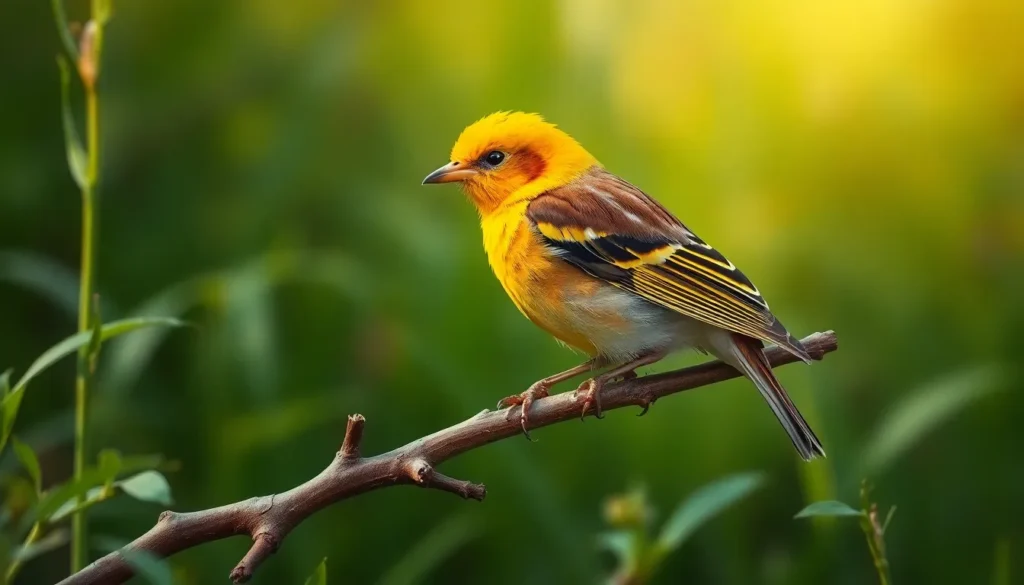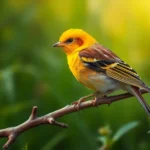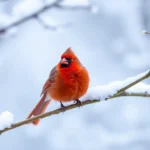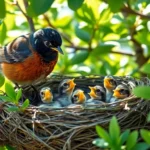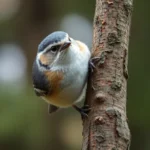We’ve all heard the distinctive song of the yellowhammer echoing across Europe’s countryside, but many of us struggle to identify this remarkable bird in the wild. With its bright yellow head and melodious call that sounds like “little-bit-of-bread-and-no-cheese,” the yellowhammer has captured birdwatchers’ hearts for generations.
These stunning members of the bunting family aren’t just beautiful to observe – they’re fascinating creatures with unique behaviors and an important role in our ecosystems. From their intricate nesting habits to their seasonal migration patterns, yellowhammers offer endless opportunities for discovery.
Whether you’re a seasoned birder looking to expand your knowledge or a curious nature enthusiast wanting to learn about local wildlife, we’ll guide you through everything you need to know about these golden-crowned songbirds. Let’s explore what makes the yellowhammer one of Europe’s most beloved and recognizable birds.
Physical Characteristics of the Yellowhammer Bird
The yellowhammer stands out among European songbirds with its robust build and vibrant coloration that makes field identification remarkably straightforward. We observe these distinctive features across their range from the Scottish Highlands to Mediterranean coastlines.
Size and Build
Yellowhammers measure 16 to 17 centimeters in length with a wingspan ranging from 23 to 29 centimeters. Their compact bodies weigh between 20 to 36 grams, placing them in the medium-sized bunting category. The bird’s sturdy frame features a relatively large head proportionate to its body and a thick, conical bill designed for seed cracking. Their legs appear strong and pale pink in color, supporting their ground-foraging lifestyle across open landscapes.
Distinctive Plumage and Markings
The yellowhammer’s most striking feature centers on its bright yellow head and underparts that give the species its common name. Adult birds display rich golden-yellow coloration on their heads, throats, and bellies, contrasting sharply with chestnut-brown backs streaked with darker markings. Their wings show distinctive rufous patches visible both at rest and in flight. The rump appears bright yellow, creating a flash of color when the bird takes off. Dark streaking patterns across the breast and flanks vary in intensity between individuals, creating unique identification markers for experienced observers.
Male vs Female Differences
Male yellowhammers exhibit more intense yellow coloration than females, particularly during breeding season from April through August. Breeding males showcase brilliant lemon-yellow heads with minimal streaking, while their backs display richer chestnut tones. Females present more subdued coloring with extensive brown streaking across their yellow underparts and duller head coloration. Outside breeding season, males lose some of their vibrant appearance, making sex determination more challenging in autumn and winter months. Young birds resemble adult females but show even more extensive streaking patterns and paler overall coloration until their first molt.
Habitat and Distribution
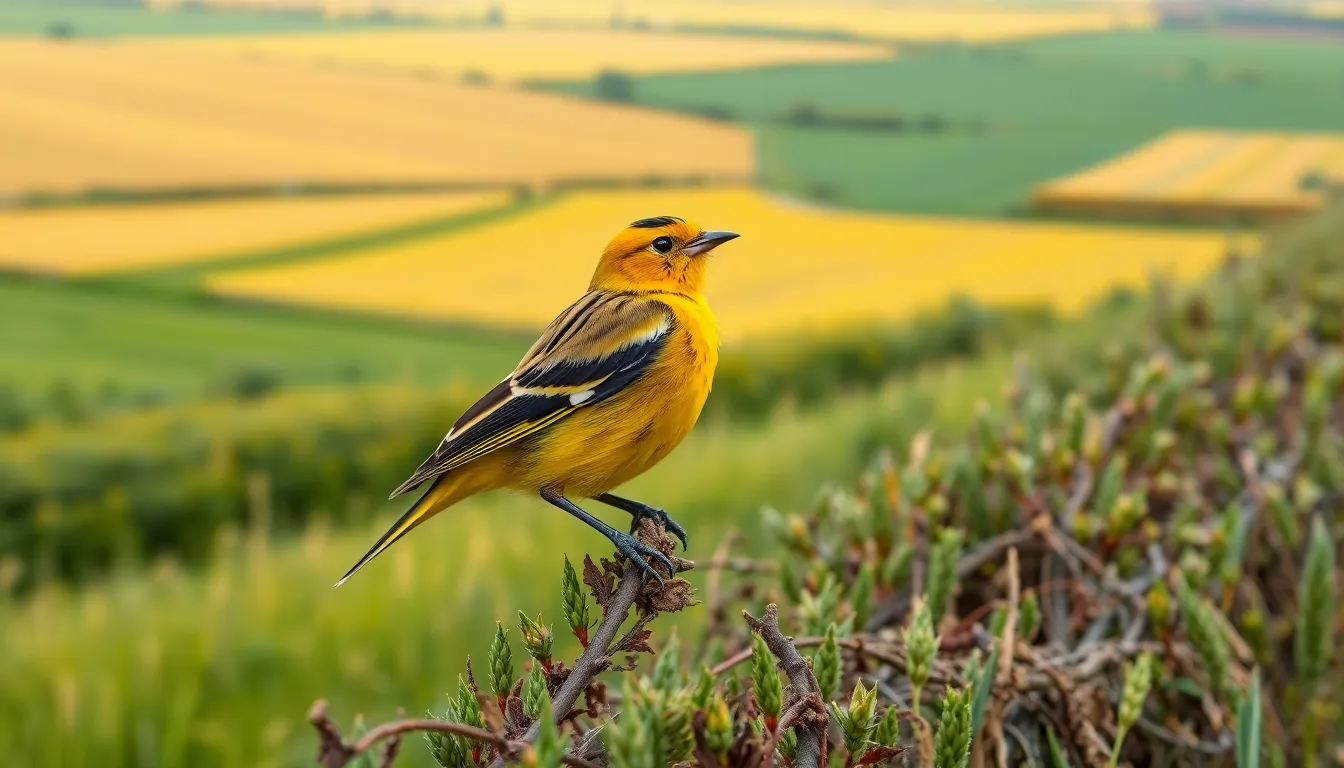
Yellowhammers occupy diverse landscapes across Europe and parts of Asia, adapting to various environmental conditions that support their feeding and breeding requirements. These adaptable birds demonstrate remarkable flexibility in habitat selection while maintaining exact preferences for open countryside environments.
Natural Range and Geographic Spread
Europe serves as the primary stronghold for yellowhammer populations, with distributions extending from Scandinavia in the north to the Mediterranean regions in the south. Breeding populations thrive across the United Kingdom, Ireland, and continental Europe, reaching eastward through Russia and into parts of western Asia. Scotland supports important numbers even though challenging terrain, while England and Wales maintain stable populations throughout agricultural regions.
Migration patterns vary considerably across different populations, with northern birds traveling south during winter months while southern populations remain largely sedentary. Eastern European yellowhammers often migrate to Mediterranean countries and North Africa during harsh winter periods. Western populations typically exhibit shorter migration distances, moving from upland areas to coastal lowlands when temperatures drop.
International distribution data shows yellowhammers present in approximately 45 countries, with breeding confirmed in 38 of these nations. Population estimates suggest between 54 to 93 million individuals exist globally, though numbers fluctuate based on habitat availability and agricultural practices.
Preferred Environmental Conditions
Agricultural landscapes provide optimal yellowhammer habitat, particularly areas combining cultivated fields with hedgerows and woodland edges. Mixed farming systems offering cereal crops, grasslands, and scattered trees create ideal conditions for both foraging and nesting activities. Traditional farming practices that maintain field margins and hedge networks support higher yellowhammer densities compared to intensive monoculture systems.
Elevation preferences typically range from sea level to 800 meters, though some populations occur at higher altitudes in mountainous regions. Climate tolerance spans temperate and boreal zones, with annual temperature ranges between 5°C and 20°C proving most suitable for breeding success.
Vegetation structure plays a crucial role in habitat selection, with yellowhammers favoring areas containing 30 to 70 percent shrub cover interspersed with open ground. Hedgerows measuring 2 to 4 meters in height provide optimal nesting sites, while adjacent grasslands and stubble fields offer essential feeding opportunities. Winter habitat requirements include seed rich environments such as weedy field margins, rough grassland, and areas with persistent crop residues.
Behavior and Lifestyle
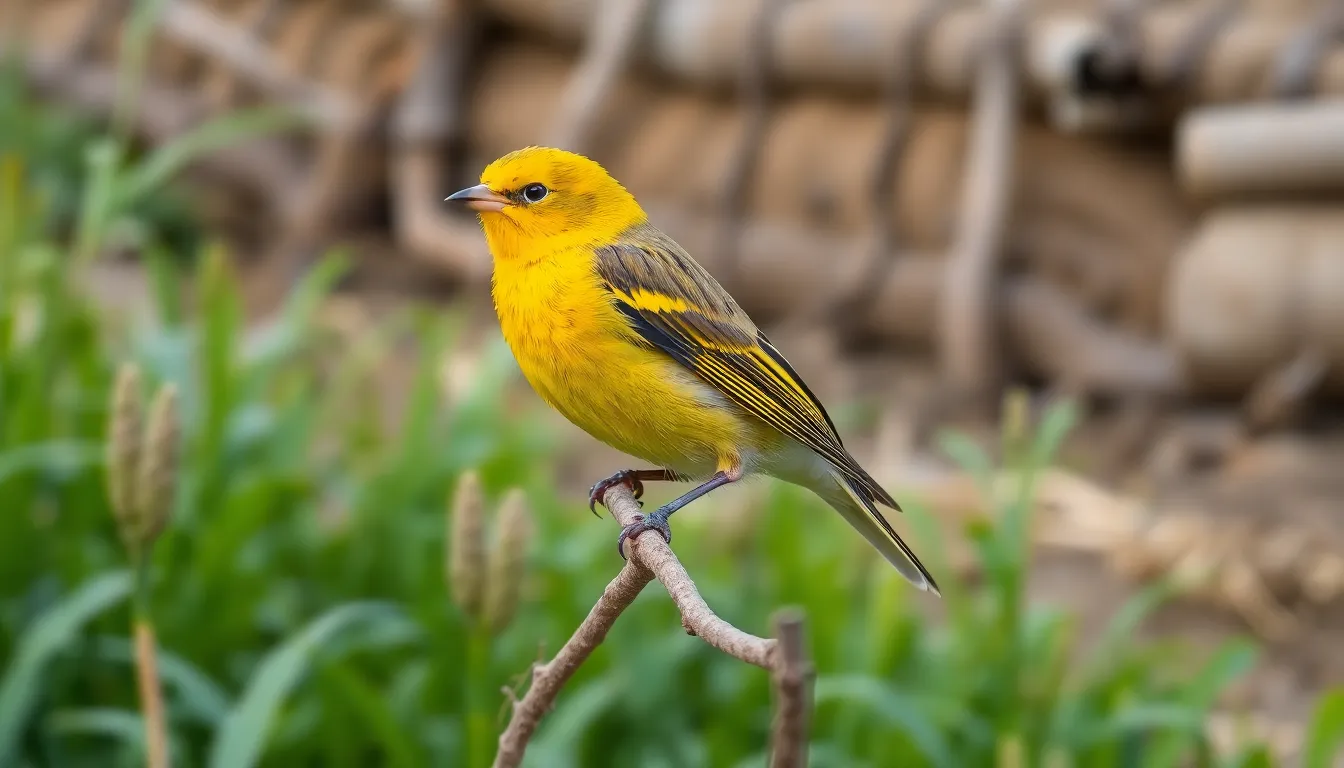
Yellowhammers demonstrate complex behavioral patterns that adapt seasonally to their agricultural environments. These fascinating birds exhibit distinct feeding strategies, breeding rituals, and social dynamics throughout their annual cycle.
Feeding Habits and Diet
Yellowhammers consume a diverse diet that changes dramatically between seasons, reflecting their adaptability to agricultural landscapes. During breeding season from April through August, these birds primarily feed on invertebrates including beetles, caterpillars, spiders, and aphids to meet the high protein demands of reproduction. Adults collect insects to feed their nestlings, making up to 95% of chick diets during the first two weeks of life.
Winter feeding behavior shifts toward seed consumption as invertebrates become scarce. Yellowhammers forage extensively on cereal grains including wheat, barley, and oats found in stubble fields and farmyards. Seeds from grasses, weeds, and wildflowers constitute 80% of their winter diet. Common plant species in their diet include dock, sorrel, chickweed, and various grass seeds.
Foraging typically occurs on the ground where yellowhammers hop and scratch through leaf litter and soil. These birds often feed in small groups during winter months, concentrating around farm buildings and areas with spilled grain. Field margins with dense vegetation provide crucial foraging opportunities throughout the year.
Mating and Breeding Patterns
Yellowhammer breeding season extends from April through September, with most pairs producing 2-3 broods annually in favorable conditions. Males establish territories averaging 0.5 to 2 hectares in size, defending areas with suitable nesting sites and food resources through aggressive displays and territorial songs.
Courtship displays involve males performing elaborate rituals including wing drooping, tail spreading, and ritualized feeding of females. Pair bonds typically form in early April, with some partnerships lasting throughout the entire breeding season. Males continue singing from prominent perches to attract mates and maintain territorial boundaries.
Nest construction takes place low in dense vegetation, usually 0.5 to 1.5 meters above ground in hedgerows, bramble patches, or field margins. Females build cup shaped nests using grass stems, moss, and roots, lining them with fine grasses and animal hair. Construction requires 3-6 days of intensive work by the female.
Egg laying occurs between late April and early August, with clutches containing 3-5 glossy white eggs marked with dark scribbled lines. Incubation lasts 12-14 days, performed exclusively by females while males provide food and territory defense. Nestlings fledge after 11-13 days but remain dependent on parents for an additional 2-3 weeks.
Social Structure and Flocking Behavior
Yellowhammers exhibit complex social dynamics that vary significantly between breeding and non breeding periods. During breeding season, these birds maintain strict territorial boundaries with pairs defending exclusive areas against conspecific intrusion. Territory sizes fluctuate based on habitat quality and food availability.
Winter flocking behavior creates mixed species assemblages containing yellowhammers, reed buntings, finches, and sparrows. Flocks typically range from 10-50 individuals but can exceed 200 birds in optimal feeding areas. These gatherings provide advantages including increased foraging efficiency and enhanced predator detection through collective vigilance.
Communication within flocks relies on exact contact calls that maintain group cohesion during feeding and movement. Alarm calls alert group members to potential threats including raptors, cats, and human disturbance. Dominance hierarchies develop within winter flocks, with older males typically achieving higher status and priority access to premium feeding locations.
Roosting behavior involves communal gatherings in dense vegetation including hedgerows, scrubland, and reedbeds. Winter roosts can contain several hundred individuals from multiple species, providing thermal benefits and protection from predators. Yellowhammers often return to the same roosting sites repeatedly throughout winter months.
The Yellowhammer’s Distinctive Song
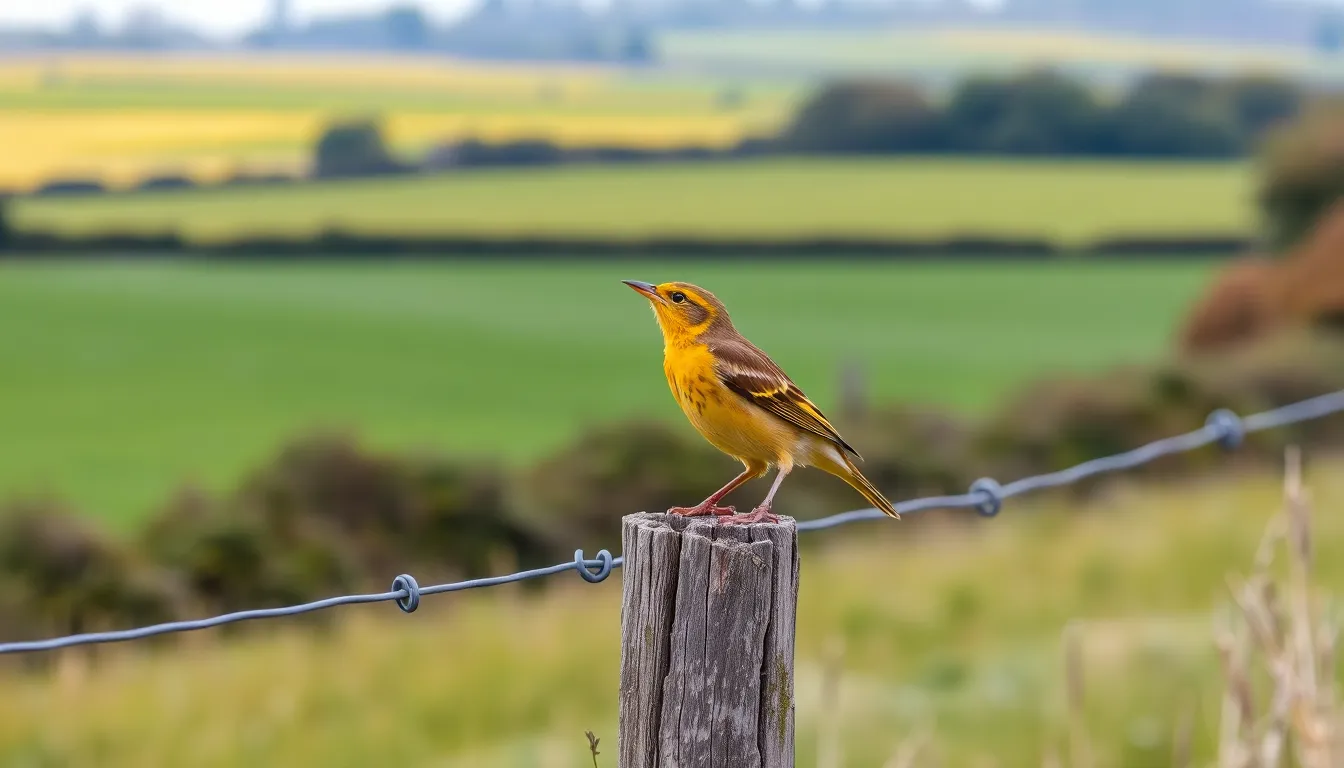
The yellowhammer’s voice creates one of Europe’s most recognizable countryside sounds. We can easily identify these bunting birds through their characteristic vocalizations that echo across agricultural landscapes throughout their range.
Vocal Characteristics and Calls
Yellowhammer songs consist of a distinctive phrase traditionally described as “little bit of bread and no cheese.” We hear this 6-7 note sequence beginning with repetitive introductory notes followed by a drawn-out terminal note. Males deliver these songs from prominent perches including fence posts, hedgerow tops, and telegraph wires.
Song frequency ranges between 3-8 kHz with each phrase lasting 2-3 seconds. We observe males repeating their songs up to 10 times per minute during peak territorial periods. The terminal note drops in pitch and extends for 0.5-1 second, creating the characteristic wheeze that distinguishes yellowhammers from other bunting species.
Flight calls produce sharp “zik” or “tzik” sounds lasting 0.1 seconds. We notice these contact calls occur frequently when yellowhammers move between feeding areas or maintain flock cohesion during winter months. Alarm calls consist of rapid “tik-tik-tik” sequences delivered at 6-8 notes per second when predators approach nesting sites.
Juvenile yellowhammers produce subsongs resembling adult vocalizations but lack the complete phrase structure. We document young birds practicing songs for 4-6 weeks before developing full adult repertoires during their first breeding season.
Seasonal Singing Patterns
Peak singing activity occurs from April through July during the breeding season. We record males singing most intensively during dawn chorus between 4:30-6:00 AM and evening periods from 6:00-8:00 PM. Song output reaches maximum levels during territory establishment in April and May.
Temperature influences daily singing patterns with optimal vocal activity occurring at 15-25°C. We observe reduced singing during extreme weather conditions including heavy rain, strong winds exceeding 20 km/h, and temperatures below 5°C.
Males maintain territorial songs throughout the breeding season but intensity decreases after pair bonding occurs. We document second and third brood cycles stimulating renewed singing activity as males reinforce territory boundaries and attract replacement mates.
Winter singing patterns show dramatic reduction with occasional songs occurring during mild weather periods in February and March. We note these early season songs indicate territory prospecting behavior as males assess potential breeding locations before full spring arrival.
Conservation Status and Threats
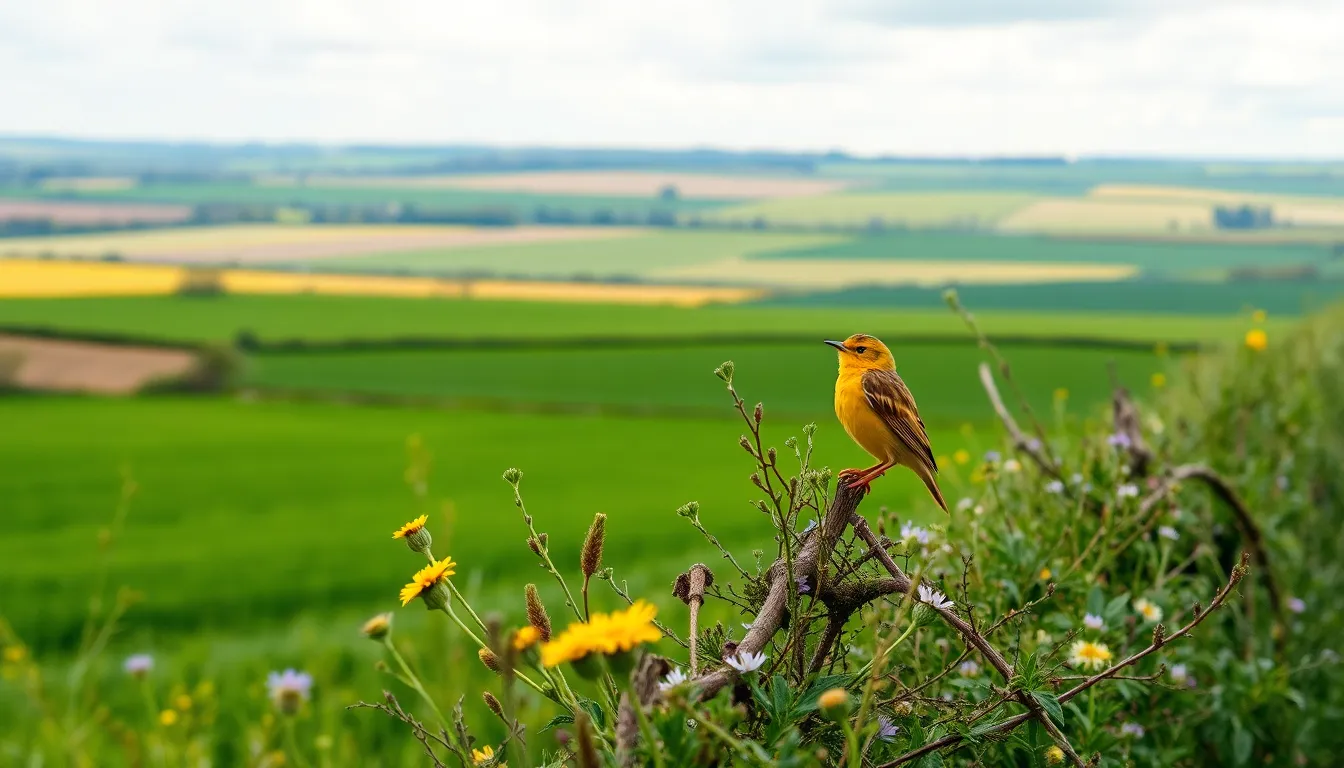
Yellowhammer populations face important declines across their European range, with conservation organizations now classifying the species as a priority for protection efforts. We observe concerning trends that highlight the urgent need for targeted conservation strategies.
Current Population Trends
European yellowhammer populations have declined by approximately 50% since the 1980s, with some countries reporting even steeper losses. Agricultural regions in the United Kingdom experienced a 54% population decrease between 1995 and 2016 according to the British Trust for Ornithology. France documented similar patterns with a 48% decline over the same period.
Regional variations in population trends reveal different conservation challenges across yellowhammer territories:
| Country | Population Change (1995-2016) | Current Status |
|---|---|---|
| United Kingdom | -54% | Red List species |
| Germany | -42% | Declining |
| France | -48% | Near threatened |
| Netherlands | -38% | Vulnerable |
| Poland | -31% | Stable to declining |
Northern European populations show more dramatic declines compared to Mediterranean regions, where yellowhammer numbers remain relatively stable. We attribute these regional differences to varying agricultural practices and habitat management approaches.
Environmental Challenges and Human Impact
Agricultural intensification represents the primary threat to yellowhammer populations across Europe. Modern farming practices eliminate the hedgerows and mixed farming systems that yellowhammers depend on for nesting sites and food sources. Farmers now cultivate larger fields with fewer boundary features, reducing available habitat by an estimated 60% in major agricultural areas.
Pesticide use creates cascading effects on yellowhammer survival by reducing invertebrate prey availability during critical breeding periods. We document correlations between intensive pesticide applications and local yellowhammer population declines in agricultural landscapes. Chemical treatments targeting crop pests also eliminate the arthropods that yellowhammer chicks require for proper development.
Climate change compounds existing pressures through altered precipitation patterns and temperature fluctuations that affect breeding success. Warmer springs can trigger earlier nesting attempts, but late frosts then destroy eggs and nestlings when natural food sources aren’t yet available. We observe mismatched timing between peak invertebrate abundance and yellowhammer breeding cycles in regions experiencing rapid climate shifts.
Urban expansion continues fragmenting yellowhammer habitats, particularly in suburban areas where traditional farmland transitions to residential development. Construction activities destroy nesting sites and create barriers between feeding and breeding areas. We identify habitat fragmentation as a critical factor limiting yellowhammer population recovery in densely populated regions.
How to Identify and Observe Yellowhammer Birds
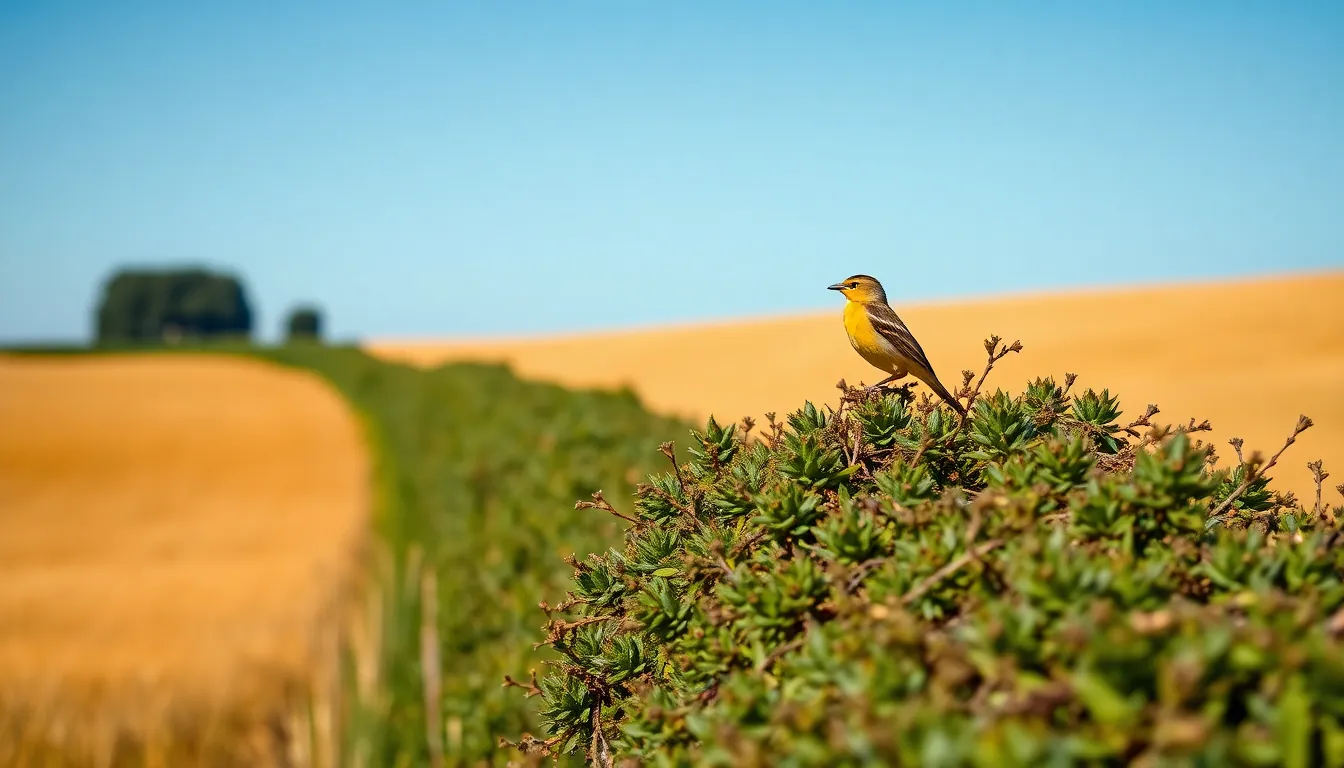
Successfully identifying yellowhammer birds requires understanding their distinctive features and knowing when and where to look for them. We’ve developed practical strategies that make spotting these vibrant buntings more effective for both novice and experienced observers.
Best Times and Locations for Spotting
Dawn and dusk provide optimal opportunities for yellowhammer observation when males sing most actively from prominent perches. Agricultural landscapes with hedgerows offer the highest success rates, particularly areas where mixed farming systems create diverse habitat structures.
Breeding season observation from April through August yields the best results since males display territorial behaviors and sing continuously throughout daylight hours. Open farmland edges, particularly near cereal fields and grassland borders, concentrate yellowhammer activity during feeding periods.
Winter months require different approaches as yellowhammers form mixed species flocks in stubble fields and weedy areas. Temperature influences their activity patterns significantly, with warmer days producing more movement and vocalization than cold periods.
Elevation considerations matter for location selection, as yellowhammers prefer areas below 500 meters where agricultural activity creates suitable habitat conditions. Hedgerow networks connecting different field types support the highest population densities and offer multiple viewing opportunities.
| Optimal Viewing Conditions | Success Rate | Time Period |
|---|---|---|
| Dawn chorus (5-7 AM) | 85% | April-August |
| Evening activity (6-8 PM) | 78% | March-September |
| Winter flocking areas | 65% | November-February |
| Warm sunny mornings | 82% | Year-round |
Tips for Birdwatchers and Nature Enthusiasts
Binoculars with 8×42 or 10×42 magnification provide ideal yellowhammer viewing without disturbing their natural behaviors. Position yourself 20-30 meters from hedgerows and maintain stillness to observe their feeding and territorial displays.
Listen for the distinctive “little bit of bread and no cheese” song pattern that males deliver repeatedly from exposed perches. Recording capabilities enhance identification skills as yellowhammer vocalizations include exact call variations for different situations.
Movement patterns distinguish yellowhammers from similar species, as they hop along ground surfaces rather than walking when foraging. Their flight appears undulating with distinctive wing beats that create recognizable silhouettes against open sky.
Clothing selection impacts observation success, with earth tone colors reducing disturbance compared to bright or contrasting garments. Weather awareness improves timing since yellowhammers increase activity levels during calm conditions and decrease movement during strong winds.
Field guides focusing on European buntings enhance identification accuracy by highlighting key distinguishing features between yellowhammers and related species. Seasonal plumage variations require attention as winter birds display more subdued coloration than breeding adults.
Photography opportunities increase when observers remain patient near known territorial perches where males return consistently throughout morning hours. Ethical distance maintenance protects nesting birds while still allowing clear observation of behavioral patterns and physical characteristics.
Conclusion
The yellowhammer stands as one of Europe’s most captivating songbirds yet faces an uncertain future that demands our immediate attention. We’ve explored how these remarkable birds have adapted to agricultural landscapes while maintaining their distinctive charm and ecological significance.
Understanding the yellowhammer’s needs helps us appreciate why targeted conservation efforts are essential for their survival. Their declining populations serve as an important indicator of broader environmental changes affecting our countryside ecosystems.
Whether you’re planning your first yellowhammer observation or working to support their conservation we hope this guide empowers you to make a meaningful difference. Every action we take today contributes to preserving these golden songsters for future generations to enjoy.
Frequently Asked Questions
What does a yellowhammer bird look like?
Yellowhammers are medium-sized birds measuring 16-17 cm in length with a 23-29 cm wingspan. They feature bright yellow heads and underparts contrasting with chestnut-brown backs streaked with darker markings. Males display more intense yellow coloration during breeding season, while females have subdued colors with extensive streaking. They weigh between 20-36 grams and are part of the bunting family.
Where can I find yellowhammers in Europe?
Yellowhammers inhabit diverse landscapes across Europe and parts of Asia, with their primary stronghold from Scandinavia to the Mediterranean. They thrive in agricultural areas with hedgerows and mixed farming systems. Northern populations migrate south in winter, while southern populations remain year-round. They prefer areas with mixed vegetation structure and elevation ranges that support their feeding and nesting needs.
What do yellowhammers eat?
Yellowhammers have seasonal feeding habits that change dramatically throughout the year. During breeding season, they primarily consume invertebrates to meet high protein demands for reproduction. In winter, they shift to a seed-based diet including cereal grains and various plant seeds. This dietary flexibility helps them adapt to different seasonal food availability in agricultural environments.
When is the best time to spot yellowhammers?
The optimal times for observing yellowhammers are dawn and dusk, particularly during breeding season from April to August when males are most active and vocal. Agricultural landscapes with hedgerows provide the best spotting opportunities. Listen for their distinctive song described as “little bit of bread and no cheese” to locate them more easily.
Are yellowhammers endangered?
Yellowhammer populations have declined by approximately 50% since the 1980s across Europe, making them a species of conservation concern. Agricultural intensification, habitat loss, pesticide use, and climate change are primary threats. Modern farming practices have reduced their available habitats by an estimated 60%. Targeted conservation strategies are urgently needed, especially in the UK and France.
What does a yellowhammer’s song sound like?
Yellowhammers produce one of Europe’s most recognizable bird songs, often described as “little bit of bread and no cheese.” Males sing from prominent perches during breeding season, particularly at dawn and dusk. Their vocalizations include various calls for communication, territory establishment, and mate attraction. Juvenile birds practice their songs before developing full adult repertoires.
How do yellowhammers behave during breeding season?
During breeding season, males establish territories and perform elaborate courtship displays. Females build cup-shaped nests in dense vegetation and typically produce 2-3 broods annually. Nestlings fledge after 11-13 days. Males become highly territorial during this period, while in winter they form mixed-species flocks for enhanced foraging efficiency and predator protection.

